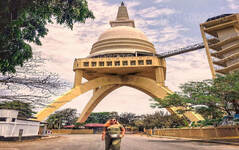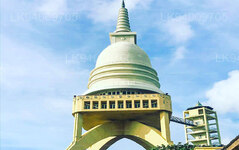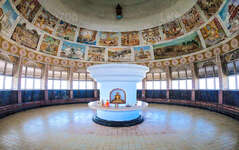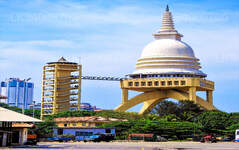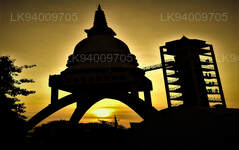
Colombo City
Colombo, hovedstaden i Sri Lanka, er en dynamisk by, der blander tradition og modernitet. Den fremviser kolonial arkitektur, livlige markeder og fredfyldte buddhistiske templer. Med et varieret køkken, en voksende skyline og smukke strande er det et pulserende knudepunkt for forretning, kultur og turisme, der tilbyder en indgang til at udforske Sri Lankas vidundere.
Sambodhi Chaithya
Sri Lanka is a very religious place with a large number of temples, mainly Buddhist and Hindu ones. While some of them are relatively new and mundane, others have an interesting history or story to tell. Colombo, in particular, has an almost even spread of historic religious sites representing all the religions within the island; Buddhism, Hinduism, Christianity and Islam.
Sambodhi Chaithya is a Buddhist Temple with a very unique and interesting architecture. Located within the harbor of Colombo, it stands on a two diagonally intersecting concrete arches that are 11 stories (33m) tall.
The History
The entire structure was designed in 1956 by a highly reputed local engineer, A.N.S. Kulasinghe. The entire project was initiated as part of the commemoration of 2,500 years since the creation of Buddhism reckoned after the Parinirvana (Passing Away) of Gautama Buddha. Named Sri Sambuddha Jayanthi Chaithya after the event’s name, the temple was designed to be viewable by incoming ships, even during storms and bad weather.
The Architecture
The white stupa is bell-shaped, as opposed to the more commonly used dome-shape in modern Sri Lankan architecture, and placed on a square one-story platform balanced on the center of the arches and supported by four struts. The stupa alone is 47m (154 feet) tall, including the conical spire and jeweled pinnacle on top.
A stupa is called a chaithya when it’s built combined with a preaching hall; in other words if it’s a place where Buddhism is taught to many students. In the case of Sambodhi Chaithya, the hall lies beneath stupa – within the one story platform. This platform has four rooms, all representing a single-roomed solitary spiritual cultivation abode usually located in forests, but here it has been customized to a port-city setting for those who wish to still the mind.
Visiting the Chaithya
The Chaithya is located at the end of the road that runs past the Colombo Lighthouse. You will find this fantastic piece of architecture surrounded by grassy spaces, shady trees, and pools of water with picturesque little arched bridges crossing them. The premises are open from early in the morning till 6:00 pm, and entrance is free.
The stupa is reached by climbing up several flights of stairs in a vertical tower alongside. There are a total of 258 steps – a height of 11 floors, all of which have to be climbed barefoot in respect to the temple. You will have to take off your footwear at the base of the tower. The concrete stairway can get burning hot when the sun get high, so you may find it easier to do the climb early in the morning or towards the evening when the heat is lower.
At the top, you will be afforded awe-striking views of the surrounding landscape and the sea. So keep your cameras ready. The access to the stupa is through a heavy steel bridge, crossing the empty space between the staircase tower and Sambodhi Chaithya. The railings are high and very secure so that even the smallest children are safe.
Once you reach the chaithya, you will find yourself passing through heavy wooden doors into the meditation/ preaching hall. From there a staircase will lead up to the main temple. The inner part of the bell-like structure is designed and painted in such a way, that it gives the illusion of being in the endless heavens. The completely while inner walls; the bluish painted on glow emanating from the little flat circle that forms roof of the upside down bell like inner structure; the four devas (heavenly residents in Buddhist culture), on plinths along the walls at cardinal points, with their hands pressed together in worship; all add to this effect. At the middle of it all is the cylindrical shrine with four golden Buddha statues that form the centerpiece.
The upper walls of the inner temple are painted with beautifully detailed scenes from the life of Gautama Buddha and regarding the creation of Sambodhi Chaithya. The art style and color schemes of these murals are faintly Asiatic and do not resemble the usual Sri Lankan traditional boldly colored Buddhist artwork that graces the walls of many temples. These murals were hand painted in November 1986 by the famous local artist and artisan Ven. Mapalagama Vipulasara Maha Thera, who is well known in international circles for his Buddhist artwork and sculptures.
Below the murals are decorative windows looking onto the landscape and the sea, while bas-relief panels regarding Buddhism decorate the lower end of the walls below the windows. The entire effect is that of an attractive art museum more than a traditional temple, and goes towards showing the changes in culture and tradition that Buddhism and Sri Lanka as a whole are undergoing.
After viewing the stupa, and climbing down the multitude of stairs; you can roam around the grounds and see the Bo Tree planted by Lady Srimavo Bandaranaike, along with a number of old anchors, canons, massive chains from ships dating back to the Dutch era, and a vintage steam crane. The Chaithya is also close to the Sri Lanka Ports Authority Maritime Museum, which is housed in a former Dutch prison built in 1676.
With so much to see, a visit to the chaithya is definitely a fun thing to do in Colombo.
Om Colombo-distriktet
Colombo er Sri Lankas største by og handelshovedstad. Den ligger på øens vestkyst og støder op til Sri Jayewardenepura Kotte, Sri Lankas hovedstad. Colombo er en travl og pulserende by med en blanding af moderne liv og koloniale bygninger og ruiner og en bybefolkning på 647.100. Colombo Metropolitan Region, defineret af distrikterne Colombo, Gampaha og Kalutara, har en anslået befolkning på 5.648.000 og dækker et areal på 3.694,20 km². Colombo er en multietnisk, multikulturel by. Det er den mest folkerige by i Sri Lanka med 642.163 mennesker, der bor inden for bygrænsen. Befolkningen i Colombo er en blanding af adskillige etniske grupper, primært singalesere, maurere og tamiler. Der er også små samfund af mennesker med kinesisk, portugisisk, hollandsk, malaysisk og indisk oprindelse, der bor i byen, samt adskillige europæiske udlændinge. Langt de fleste srilankanske virksomheder har deres hovedkontorer i Colombo. Nogle af industrierne omfatter kemikalier, tekstiler, glas, cement, lædervarer, møbler og smykker. I byens centrum ligger Sydasiens næsthøjeste bygning - World Trade Center.
Om Vestprovinsen
Vestprovinsen er den tættest befolkede provins i Sri Lanka. Den er hjemsted for den lovgivende hovedstad Sri Jayawardenepura Kotte samt Colombo, landets administrative og forretningsmæssige centrum. Vestprovinsen er opdelt i 3 hoveddistrikter kaldet Colombo (642 km²), Gampaha (1.386,6 km²) og Kalutara (1.606 km²). Som Sri Lankas økonomiske centrum er alle de store lokale og internationale virksomheder til stede i byen, ligesom alle de store designer- og detailhandlere, så vær klar til at forkæle dig selv med lidt shoppingterapi i den vestlige provins. Med den højeste befolkning i alle provinser er næsten alle de førende uddannelsesinstitutioner på øen placeret i den vestlige provins. Universiteterne i provinsen omfatter University of Colombo, University of Sri Jayewardenepura, University of Kelaniya, Open University, Sri Lanka, Buddhist and Pali University of Sri Lanka, General Sir John Kotelawala Defence University og University of Moratuwa. Den vestlige provins har det største antal skoler i landet, herunder nationale, provinsielle, private og internationale skoler.

